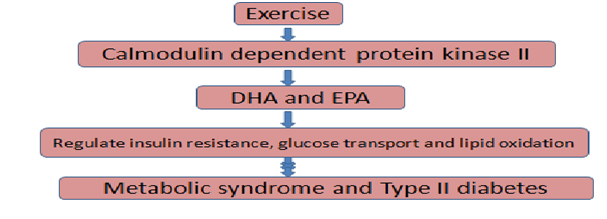Calmodulin dependent protein kinase (CaMK)-II activation by exercise regulates omega-3 polyunsaturated fatty acids biosynthesis in rat skeletal muscle

Abstract
Calmodulin dependent protein kinase(CaMK)-II activation has been associated with many cellular functions beneficial to human health, especially metabolic syndrome and type 2 diabetes. Omega-3 polyunsaturated fatty acids shown to have positive effects on metabolic syndrome and type 2 diabetes;especiallydocosahexaenoic acid (DHA) and eicosapentaenoic acid (EPA) which are synthesized from alpha-linolenic acid (ALA) acquired from diet. Using Gas chromatography-mass spectrometry, we found that exercise induced CaMKII activation regulate the biosynthesis of DHA and EPA. Addition of N-[2-[N-(4-Chlorocinnamyl)-N-methylaminomethyl] phenyl]-N-(2-hydroxyethyl)-4-methoxybenzenesulfonamide (KN93) (CaMKII inhibitor) in the exercised rats group resulted in the biosynthesis attenuated to levels similar to the control group. Furthermore, of Peroxisome proliferator-activated receptor gamma coactivator 1(PGC-1), a co-activator also involved in lipid metabolism was found to have been increased with CaMKII activation. Here we show for the first time that CaMKII activation controls the metabolism of omega-3 fatty acids, DHA and EPA which has significant implications in the regulation of metabolic diseases. Therefore, CaMKII can be a target to design therapeutic modalities required to cure or better manage metabolic syndrome and type 2 diabetes.



